Pearl gouramis top the list for aquarists looking for a hardy, gorgeous, easy to manage gouramis.
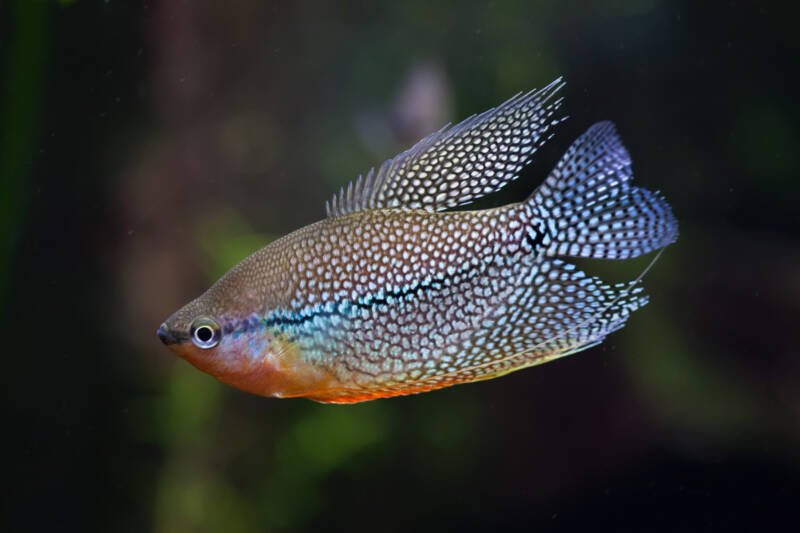
They tolerate a wide range of water conditions, aren’t difficult to breed, and have one of the more peaceful temperaments in the labyrinth fish group.
These stunning fish display opalescent white spots across their bodies, with a striking black lateral line.
Sweeping ventral fins extend below and behind them, creating a dramatic look in any freshwater aquarium. You may also see them labeled diamond, mosaic, or lace gouramis.
Beginner aquarists and pros alike find little to complain about with these beautiful fish.
So if you’ve had your eye on that distinct gourami shape but don’t want to struggle with aggression or tricky water conditions, pearl gouramis are the perfect compromise.
At a Glance
| Minimum tank size: | 30 gal (114 l) |
| School size: | at least six |
| Temperature: | 72-82°F (22-28°C) |
| Lifespan: | up to 5 years |
| Size: | 4-5 inches (10-13 cm) |
| pH: | 6.5-8.0 |
| Hardness: | 5-25 dH |
| Ammonia: | 0 ppm |
| Nitrite: | 0 ppm |
| Nitrate: | <20 ppm |
In this article
In the Wild
Pearl gouramis (Trichopodus leerii) started in lowland swamps in Southeast Asia. In particular, they frequented slow-moving rivers and lakes in Borneo, Malaysia, Sumatra, and Thailand.
However, human intervention has led to people finding them in Singapore and even Columbia.
Pearls prefer shallow, acidic waters. Such habitats gave rise to the evolution of their labyrinth organ.
Like other gouramis and bettas, the labyrinth organ allows pearls to “gulp” air from the surface. The swampy regions were perfect for this development.
Unfortunately, dams, logging, and direct harvesting of these popular fish have led to pearl gouramis appearing on the IUCN Red List of Threatened Species!
This is why you’ll rarely find wild-caught pearls in pet stores. Nowadays, almost all are captive-bred.
Size: Practical Pearls
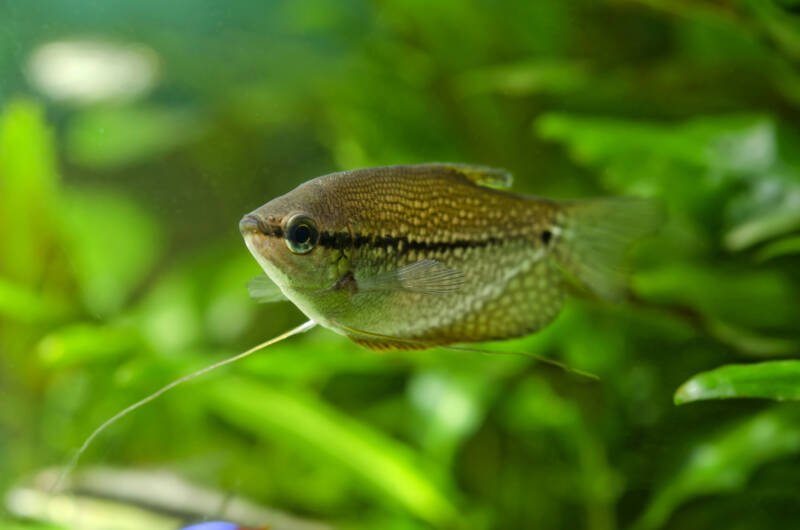
If you’re looking for a stunning centerpiece fish that won’t take up too much room, pearl gouramis fit the bill.
These fish top out around 4-5 inches or 10-13 cm as adults. Of course, that length doesn’t include those flowing ventral fins – those come extra.
Lifespan
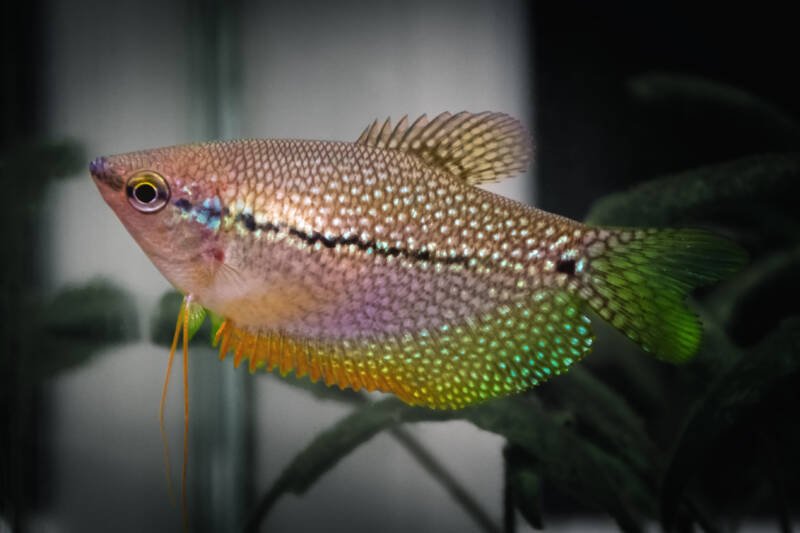
On average, pearls live around five years. It isn’t the most dramatic lifespan out there for a colorful freshwater fish, but it isn’t the shortest, either.
If you maintain perfect water conditions at all times and feed quality foods, you may see six years, but it’s rare.
Behavior
Due to their peaceful nature, pearl gouramis enjoy each other’s company – provided you respect proper male to female ratio and tank space.
Males WILL become aggressive with each other, particularly during the spawning season. You’re better off sticking to one with a group of females.
A school of six is a proper size. Even if your pearls don’t shoal together, you’ll keep their stress levels down. Anxious fish tend to hide more, have paler colors, and won’t live as long.
You want to encourage normal behaviors, including trips to the surface for breathing.
Tank Setup
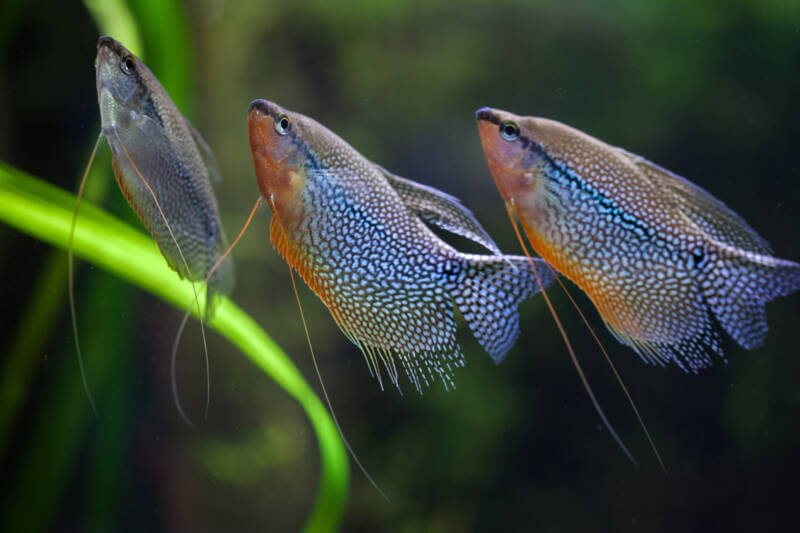
The best tank size for keeping pearl gouramis is 30 gallons (114 l).
However, if you want to keep a proper school, you need to add 5-10 gallons (19-38 l) for each additional fish.
Pearls prefer the middle and top of the water column, and they need room to swim.
Equally important is the lid for your tank. Pearls need to visit the surface to take in air across their labyrinth organ.
The cover protects against dust and other impurities from entering the water, but it also creates a safe space for your gouramis to breathe.
Pearl gouramis are tropical species. They need a water temperature between 77-82°F or 25-28°C.

They also require that air pocket to remain warm and humid. An ill-fitting lid allows drafts that can chill your pearls when they breathe. Make sure your cover fits snug.
And while filters are crucial for every aquarium, you don’t need to go overboard on the outflow.
Pearls frequent slow-moving waters, and too much water current will upset them. The AquaClear Power Filter works fine.
Unless you’ve opted for a large community tank, you can also skip air stones.
Your pearls have that pocket of trapped air for their supplemental oxygen, after all. They don’t need any extra water current. (And you can save on the expense!)
Water Conditions
While wild pearl gouramis prefer water on the acidic side, captive-bred fish tolerate a wider range.
As such, you can get away with a pH level between 6.5-8.0 without a problem. They also handle a range of water hardness, between 2-30 dH.
However, their water QUALITY tolerances aren’t as fluid. If ammonia goes above 0 ppm, you may notice them gasping for air at the surface.
They may also develop inflammation around the gills. These are signs of ammonia poisoning and need immediate rectification.
Decorating the Pearl Gourami Tank
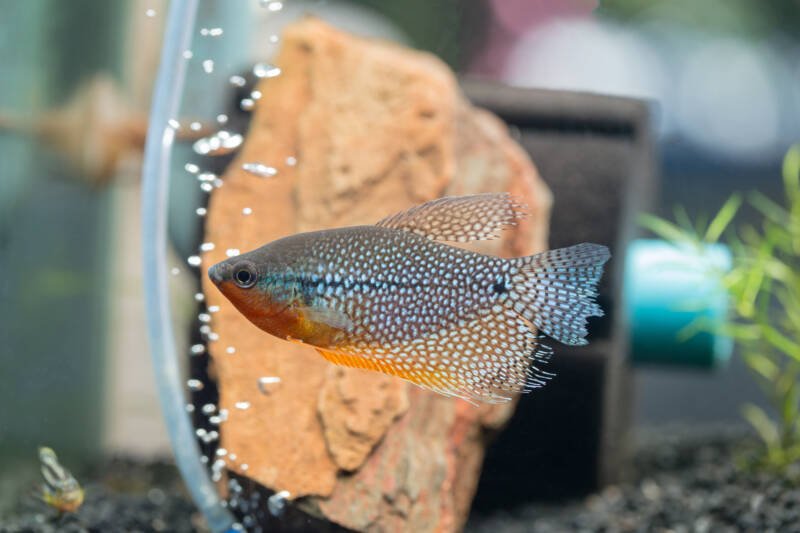
Wild pearls enjoy waters with plant cover. The greenery provides hiding places from predators, particularly as the rivers and swamps tend to the shallow side.
However, they still need plenty of room for free-swimming. It’s a careful balance.
While omnivores, pearl gouramis aren’t big on eating tank décor. This gives you a wide range of plants to choose from.
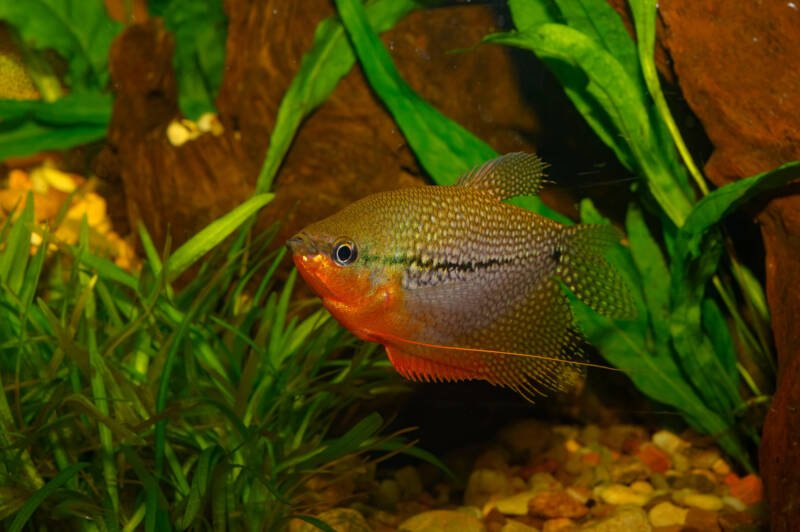
As long as you leave open space, you can fill the sides and even the tank’s top. That’s right – floating plants make an excellent pearl tank choice.Good options include:
- Anacharis
- Aponogeton
- Cabomba
- cryptocoryne
- Hornwort
- Java fern
- Vallisneria
- Water Sprite.
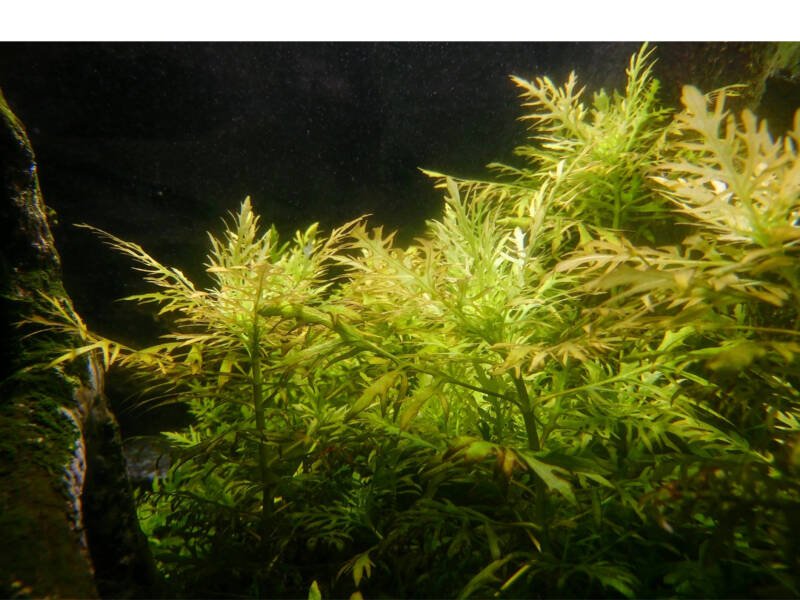
Sand or fine-grained gravel will mimic their native substrate perfectly.
You don’t need to go crazy trying to make things perfect, though. After all, pearls don’t spend much time at the bottom of the tank.
A few caves will offer hiding spaces – in case they’re needed. But try to minimize tank clutter.
If given the option, your pearls will prioritize the swimming room. And make sure they have a clear shot to the open space at the top.
Pearl Gouramis in Communities
Pearl gouramis have a peaceful temperament – outside of spawning season.
So as long as you maintain a proper ratio of one male to multiple females, they’ll do well in most community aquariums. You just need appropriate tank mates.
Tank Mates
Pearls tolerate small, schooling fish admirably well. You want to avoid species with nipping habits, as those ventral fins pose too much of a temptation.
However, they do well with plenty of other freshwater species:
- Cherry barbs
- Corydoras
- Dwarf cichlids
- German blue rams
- Guppies
- Hatchetfish
- Kuhli loach
- Large/medium rasboras
- Swordtails
- Small tetras, cardinal, lemon, and rummy nose tetras
- Platies.
If you have a mixed community tank with invertebrates, pearls work well there, too. They won’t bother your freshwater shrimp or snails in the slightest.
This way, you can keep a diverse aquarium people will want to spend hours gazing at.
Incompatible Species
Pearls don’t do as well in groups with larger or hyperactive fish. They start to feel intimidated and spend more time hiding.
If their tank mates’ activity gets too overwhelming, they may even feel too nervous to head to the surface to breathe. Stick to smaller, calmer species.
Feeding Your Pearl Gouramis
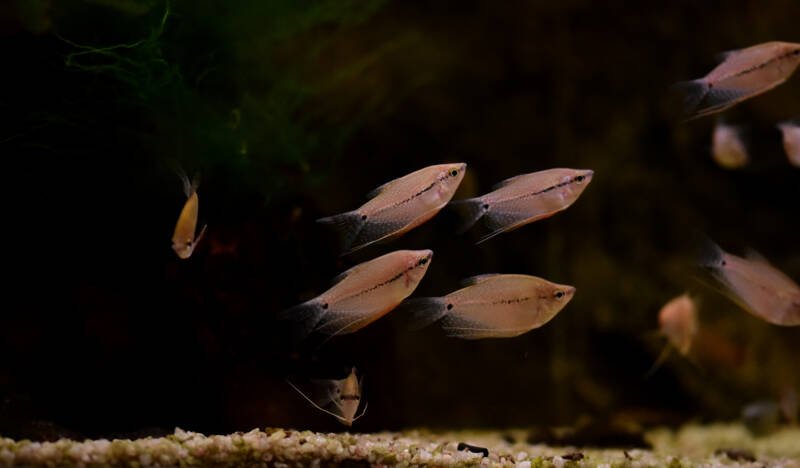
Pearl gouramis fall squarely into the omnivore category. This makes them a cinch to feed, even for novice aquarists.
They’ll accept anything you want to put on the menu without complaint – though you should aim for a variety to keep those patterns looking their best.
Particularly for the males, you want to offer reliable protein sources.
You can switch between freeze-dried, frozen, or live sources to keep your pearls on their toes.
When preparing for breeding, live options work the best. Pearl favorites include:
- Black worms
- Bloodworms
- Brine shrimp
- Glass worms.
Of course, pearl gouramis are also a secret weapon in the fight against hydra.
Those annoying aquarium pests can be difficult to eradicate in most tanks. But pearls LOVE hydra and devour them without a problem. (Not a usual diet option, but a fun fact all the same)
You don’t want to skimp on the vegetable side of things, either.
A proper balance keeps your pearls healthy and prevents bloat and constipation. You can peel, blanch, and offer the following fresh veggies:
- Lettuce
- Peas
- Spinach
- Zucchini.
Breeding: Male at Work
Like many gouramis and bettas, pearl gouramis are bubble nesters. They’re also relatively easy to breed, even for newcomers.
You’ll need a separate breeding tank, but otherwise, the fish do most of the hard work.
Males of Females?
Male gouramis have a thinner profile, especially during the spawning season.
They also carry a vibrant red streak along the throat and belly. This makes telling your guys from your girls a cinch, allowing you to organize your pairs without a problem.
Bubble Nesters
To breed your pearl gouramis, you need to set up a separate breeding tank.
Floating plants are necessary, so the bubble nest has something to anchor to. You also want to set the water temperature to a balmy 80°F (27°C).
For a few weeks prior, pre-condition your chosen pair with live foods. This triggers the spawning drive.
You’ll know you’re on the right track when the male builds his bubble nest below the floating plants.
On average, the nest is about 10 inches (25 cm) wide.
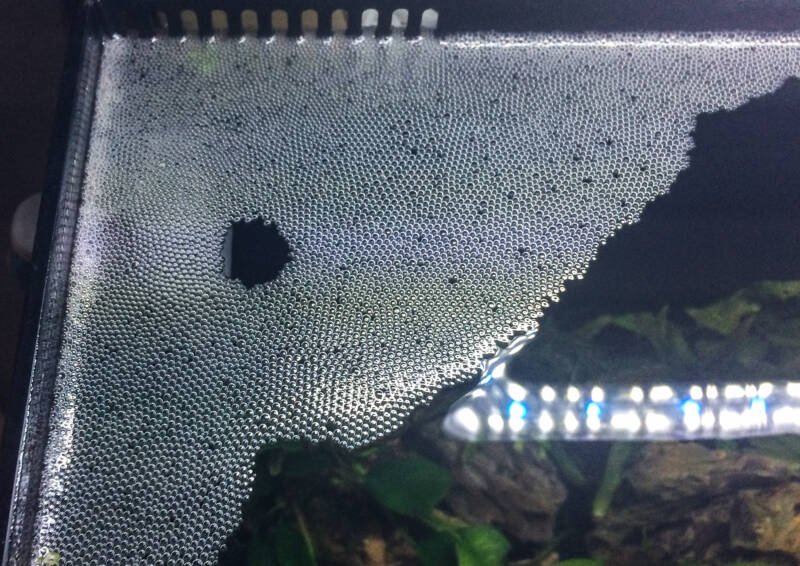
When the male’s satisfied with his nest, he’ll display underneath to attract the female.
The pair touch their ventral fins together and then spawn. A female can lay up to 200-300 eggs.
The male ensures all the eggs drift into the nest, and then he chases the female away.
You’ll want to return the female to the community tank. If left in the tank, the male will attack her.
He takes his guard duty VERY seriously. After around four days, the eggs hatch. The fry are immediately free-swimming.
The male ceases guard duty and will eat them if not removed!
You can feed the fry infusoria for the first couple of weeks. After that, they can graduate to newly-hatched brine shrimp.
At one month, you can switch to fine-ground fish flakes. Keep up with water changes every 2-3 days to prevent harmful waste build-up.
Health & Disease
One of the biggest health concerns for pearl gouramis is fin rot, particularly on those dramatic ventral fins.
If any damage occurs (or you have nipping tank mates), poor water quality allows bacteria to invade and cause discoloration or even decay of the fins.
At the first sign of fin problems, you need to increase your water changes.
There ARE antibacterial medications you can add to the water to treat the infection. However, prevention is always easier than treatment.
Other health problems pearls are subject to include:
- Bloat
- Ich
- Fish fungus
- Swim bladder disease.
Pearl Gouramis: Are They for You?
While you need to consider purchasing a school, pearl gouramis won’t break the bank.
They run an average cost between $5 – $8 per fish (courtesy of that captive-breeding program).
And while they may not live the longest, they also don’t require any specialized accessories.
For aquarists that love the flattened, trapezoidal shape of gouramis, pearls make an excellent choice.
They don’t have stringent requirements for water conditions, they stay on their best behavior, and they’re not difficult to breed. You can easily maintain your school.
Sweet Labyrinth Fish
With the delicate pattern of white spots across their bodies and those flowing ventral fins, pearl gouramis make beautiful additions to any community aquarium.
They’re as sweet as their names, and any aquarist can manage their care.
Are you an avid fan of pearl gouramis? Have you used them for hydra pest control in your tank?
How often have you seen bubble nests?
Let us know your questions and stories here!